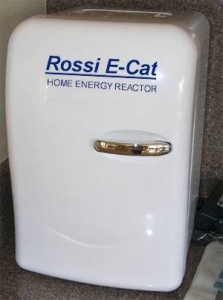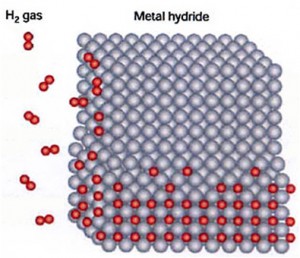The E-Cat or Energy Catalyzer, created by Andrea Rossi, has been undergoing “independent” validation and the first results reported from November and December 2012 and March 2013 tests state that the device produces excess heat equivalent to “10,000 times the energy density and 1,000 times the power density of gasoline.”
For those of you who have been reading my previous postings on cold fusion this independent study represents a very interesting cold fusion development. But some of you who are new to this blog site may be unfamiliar with the subject matter. So here is a quick explanation.
Cold fusion the way Rossi is doing it is a process that involves infusing hydrogen into nickel. This causes a reaction in which electrons from the nickel combine with hydrogen to produce neutrons which then get absorbed by the nickel converting it into copper. This process is called transmutation and a great deal of energy is one of its byproducts. It is that energy that the E-Cat can then use to power devices.
The benefit of cold fusion over hot fusion reactors such as the ITER Tokamak, is relative safety. Cold fusion happens slowly. Hot fusion is fast. Cold fusion produces little if any ionizing radiation. Hot fusion produces a ton.
In this most recent development and because of Rossi’s past reputation t is hard to know whether we are being conned or that the report is the real deal. But the results announced come from seven scientists, two from Bologna University, four from Uppsala University and one from the Royal Institute of Technology in Sweden. These scientists state:
“Measurement of the produced heat was performed with high-resolution thermal imaging cameras, recording data every second from the hot reactor tube. The measurements of electrical power input were performed with a large bandwidth three-phase power analyzer. Data were collected in two experimental runs lasting 96 and 116 hours, respectively. An anomalous heat production was indicated in both experiments. The 116-hour experiment also included a calibration of the experimental set-up without the active charge present in the E-Cat HT.”
But there is another comment in the report that puzzles me. The authors state at one point “no extra heat was generated beyond the expected heat from the electric input.” Does that mean that input equaled output? So are we not seeing a net gain in energy derived from the interaction of the elements within the E-Cat? A final comment, however, states: “Even by the most conservative assumptions as to the errors in the measurements, the result is still one order of magnitude greater than conventional energy sources.” And by conventional they mean fossil fuel derivatives like gasoline.
So has Rossi with his E-Cat produced a commercial cold fusion reactor? Are we witnessing the beginning of a revolution in energy production?
The Martin Fleischmann Memorial Project, a web site dedicated to verifying Fleischmann and Pons’ cold fusion discovery raise some interesting questions about this latest finding. On their website they state the following:
“We …. on behalf of the global population, call on the authors and Andrea Rossi to make the raw data and more detailed instrumentation details for the entire test available for verification of calculations made from the data. We are willing to host the data and help stimulate the analysis of it, or simply be another participant re-analyzing it.”
I think Rossi should take up this offer. After all if cold fusion proves viable it can be an incredible energy source and Rossi would be a leader in producing a commercial cold fusion reactor. But without independent verification to validate his claims, Rossi’s past and current secretiveness and obfuscations continue to make any of his pronouncements on cold fusion sound dubious.












